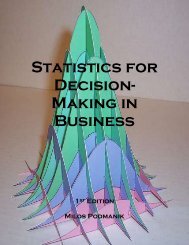Tutor Training Manual.indd - Chandler-Gilbert Community College
Tutor Training Manual.indd - Chandler-Gilbert Community College
Tutor Training Manual.indd - Chandler-Gilbert Community College
You also want an ePaper? Increase the reach of your titles
YUMPU automatically turns print PDFs into web optimized ePapers that Google loves.
12<br />
Active Learning<br />
Imagine a tutor is helping a student work a homework problem. What are the differences<br />
between passive learning and active learning<br />
Passive Learning:<br />
<strong>Tutor</strong>: “Here, let me show you how to do that.”<br />
Active Learning:<br />
<strong>Tutor</strong>: “What section of the textbook discusses this”<br />
Passive is when...<br />
• <strong>Tutor</strong> lectures or explains without engaging the student with questions.<br />
• <strong>Tutor</strong> answers the student’s questions rather than asking the student to call upon prior<br />
knowledge and skill to try to figure them out, or to consult the lecture notes, textbook, or<br />
other reference materials.<br />
• <strong>Tutor</strong> solves homework problems rather than asking the student to solve them.<br />
Active is when ...<br />
• The student does something to participate in learning to seek mastery of the material.<br />
• Activities are structured so that the student is required to do the work.<br />
• The student is engaged in the process summarizing the content he or she has learned.<br />
Active learning has the following affects:<br />
• It makes tutoring more interesting and fun.<br />
• It fosters appreciation of learning.<br />
• It helps students practice self expression, critical thinking, and self initiated inquiry.<br />
How to Stimulate Active Learning While <strong>Tutor</strong>ing<br />
The Prompt Response Method<br />
A prompt is a statement or a question that requests a response. Generally, tutors prompt<br />
with a question and students respond.<br />
The following scenario is an example of the Prompt-Response Method:<br />
<strong>Tutor</strong> (prompt): “How do I find the horizontal intercepts”<br />
Student (response): “I plug zero in the y and solve for x.”<br />
The tutor’s prompt is a leading question, a very common tutoring technique. This question<br />
helped the tutor identify the information the student has already mastered. <strong>Tutor</strong> initiated<br />
prompts should be questions designed to engage the student. See the ‘Asking the Right<br />
Questions’ section of this manual for more information about effective questioning<br />
techniques.<br />
Another example of using the Prompt-Response Method:<br />
Student (prompt): “I don’t get the difference between a domain and range.”<br />
<strong>Tutor</strong> (response): “What do you know about domain and range”<br />
The tutor did not answer the student’s question, but instead responded with another<br />
prompt in the form of a question. Again the tutor offered a prompt to help clarify for both<br />
of them the student’s level of knowledge.

















